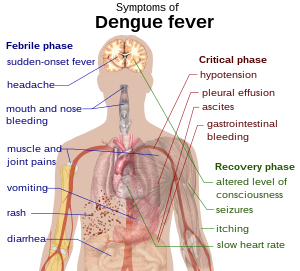Dengue fever (UK: /ˈdɛŋɡeɪ/, US: /ˈdɛŋɡiː/), also known as breakbone fever, is an infectious tropical disease caused by the dengue virus. Symptoms include fever, headache, muscle and joint pains, and a characteristic skin rash that is similar to measles. In a small proportion of cases the disease develops into the life-threatening dengue hemorrhagic fever, resulting in bleeding, low levels of blood platelets and blood plasma leakage, or into dengue shock syndrome, where dangerously low blood pressure occurs.
Dengue is transmitted by several species of mosquito within the genus Aedes, principally A. aegypti. The virus has four different types; infection with one type usually gives lifelong immunity
to that type, but only short-term immunity to the others. Subsequent
infection with a different type increases the risk of severe
complications. As there is no vaccine, prevention is sought by reducing the habitat and the number of mosquitoes and limiting exposure to bites.
Treatment of acute dengue is supportive, using either oral or intravenous rehydration for mild or moderate disease, and intravenous fluids and blood transfusion for more severe cases. The incidence
of dengue fever has increased dramatically since the 1960s, with around
50–100 million people infected yearly. Early descriptions of the
condition date from 1779, and its viral cause and the transmission were
elucidated in the early 20th century. Dengue has become a global problem
since the Second World War and is endemic
in more than 110 countries. Apart from eliminating the mosquitoes, work
is ongoing on a vaccine, as well as medication targeted directly at the
virus.
Signs and symptoms
Typically, people infected with dengue virus are asymptomatic (80%) or only have mild symptoms such as an uncomplicated fever.[1][2][3] Others have more severe illness (5%), and in a small proportion it is life-threatening.[1][3] The incubation period (time between exposure and onset of symptoms) ranges from 3–14 days, but most often it is 4–7 days.[4]
Therefore, travelers returning from endemic areas are unlikely to have
dengue if fever or other symptoms start more than 14 days after arriving
home.[5] Children often experience symptoms similar to those of the common cold and gastroenteritis (vomiting and diarrhea),[6] but are more susceptible to the severe complications.[5]

Tidak ada komentar:
Posting Komentar